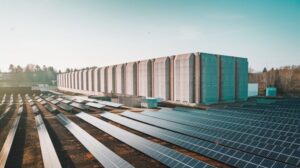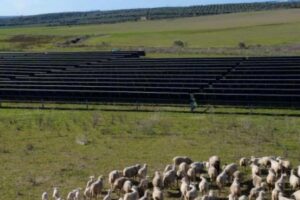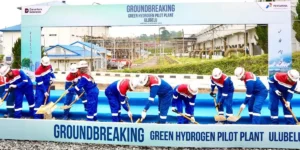A path to sustainable U.S. energy policy


(Photo by Angie Warren on Unsplash)
Contributed by John Fernandes, Policy Director, Ulteig
It’s no secret that there is unprecedented change taking place across the United States’ energy landscape. If you’re reading this article, you’re aware of the change — and you’re aware of the potential implications if we don’t take a particular course of action or if we don’t do it soon enough. Yet continuing to sound the alarm over a falling sky seems to be creating fatigue and pushback.
The US is attempting to modernize the electric grid with renewable energy targets that some feel are unrealistic or driven by bad data. On top of that, to reach these targets under current development standards, we may need a land area larger than the state of Texas and then an enormous amount of transmission to move this green energy across state lines. Additionally, there is uncertainty as to whether there is enough tax equity to help fund these projects, especially with potential changes in banking regulation.
All that being said, what if we could advance a green energy economy and ensure local reliability and resiliency without having to carve up our public lands or rely on fiscally partisan tax programs?
Advanced operational processes, appropriate compensation and cost recovery, and legal protection for those using advanced technologies could help us find practical and sustainable ways to meet both our energy needs and social objectives. With these policies in place, we could leverage proven platforms to mitigate short-term uncertainty while incentivizing the ongoing development of new solutions. To demonstrate how this could be accomplished, consider energy storage, virtual power plants, and grid automation.
Energy storage
By current technical and economic standards, energy storage is a mechanism where a lithium-based electrochemical battery provides ancillary services or leverages an arbitrage (“buy low, sell high”) strategy to deliver a few hours of energy during high system utilization. While there are exceptions, this is the general reality for storage as an asset class.
To allow storage to move beyond this narrow scope of service, market rules must stop limiting storage to short-duration, high-cycling applications. It was an innovative policy in the form of FERC Order 755 that created a financial mechanism to compensate storage for its ability to provide frequency regulation more effectively than any other resource. A similar objective-based mechanism could remunerate storage as a true reliability asset that charges with the lowest-emissions, lowest-cost marginal energy and then discharges on-demand for possibly days at a time.
GO DEEPER: Check out the Factor This! energy storage podcast playlist, including episodes on battery storage, long-duration energy storage, gravity storage, and more. Subscribe wherever you get your podcasts.
Virtual power plants
Virtual Power Plants (VPPs) aggregate distributed resources, such as solar and batteries, and load that are controlled remotely to act as a smart and cost-effective grid resource. However, there are limitations that must be addressed for VPPs to be broadly adopted.
First, the metering and communications requirements for these projects can be significant and costly. Resources or loads that are leveraging a tariff to receive revenues based on output or curtailment are typically required to provide granular, “revenue-grade” data from meters certified by the American National Standards Institute (ANSI). When a VPP operator is required to have such equipment on each participating endpoint in an aggregated system, costs climb quickly.
Second, in many instances, VPPs are constrained in the services they can offer. Many VPPs, even those with generation resources within the “plant”, are still treated as only load. This limits the financial potential of the projects.
To make these systems economically viable and practical for wider use, it’s important to manage the technical requirements and costs. VPPs should be able to simultaneously offer various services like generating power and managing electricity demand; FERC Order 2222 is helping to create consistent rules for how these types of projects can participate in markets.
VPPs can offer localized value for resiliency, reliability, and flexibility. Using smart, responsive distributed energy resources is a great way to make the goals of modernizing the U.S. power grid more achievable while managing the scale of resources required to make it happen.
Grid automation and Grid Enhancing Technologies (GETs)
Grid automation and GETs encompass perhaps the broadest category of solutions of these enablement examples and may be a top contender for early success. FERC Order 881 and, perhaps to some extent, Order 2023 are requiring grid operators to plan and operate the electric system more precisely and consider alternative processes for more efficient project interconnection.
The opportunity for new acronyms with grid automation is boundless: DLR (Dynamic Line Rating), AGIS (Advanced Grid Intelligence & Security), IVVO (Integrated Volt-Var Optimization), FAN (Field Area Network), and WiSUN (Wireless Smart Utility Network) capture just a handful. The new nomenclature represents non-traditional ways to understand and manage the power grid.
However, making these changes requires significant investment by and cost recovery for the entities who own and operate the transmission and distribution system. The question becomes how to balance requirements and incentives for owner-operators to use these new methods and processes.
This balancing act could mean the difference between getting the minimum amount of compliance versus the maximum amount of innovation. A cost recovery or revenue structure akin to performance-based rate making, where revenues are tied to a utility meeting specific objectives, can create significant upside for grid operators to make these transitions.
Renewable energy, electric vehicles, and electrification are going to happen regardless of who is holding the majority in Washington, DC. Trajectories may speed up or slow down, but the grid is going to evolve. If the US were to temper blunt, time-bound aspirations with pragmatic but innovative alternatives to traditional infrastructure and operations, we may be able to create sustainable energy policy that will indeed sustain.




